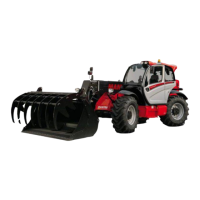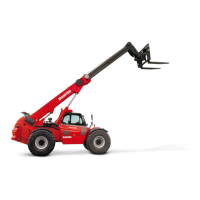1 - 21
TAKING UP A HIGH LOAD ON STABILISERS
- Ensure that the forks will easily pass under the load�
- Check the position of the telehadler with respect to the load and make a test run,
if necessary, without taking the load�
- Raise and extend the jib (1) (2) until the forks are at the level of the load (fig� G5)�
- Insert the forks under the load as far as they will go by alternately extending and
lowering the jib (1) (fig� G6)�
- Lift the load slightly (1) and tilt the carriage (2) backwards to stabilise the load (fig� G7)�
- Monitor the longitudinal stability limiter and warning device (
e INSTRUCTIONS FOR
HANDLING A LOAD: C - LONGITUDINAL STABILITY LIMITER AND WARNING DEVICE)�
If it is overloaded, set the load back down in the place from which it was taken�
- If possible lower the load without moving the telehadler� Raise the jib (1) to release
the load, retract (2) and lower the jib (3) to set the load into transport position (fig� G8)�
SETTING DOWN A HIGH LOAD ON STABILISERS
- Raise and extend the jib (1) (2) until the load is above the elevation (fig� G9), while
monitoring the longitudinal stability limiter and warning device (
e INSTRUCTIONS
FOR HANDLING A LOAD: C - LONGITUDINAL STABILITY LIMITER AND WARNING
DEVICE)�
- Position the load horizontally and release it by lowering and retracting the jib (1)
(2) to position the load correctly (fig
� G10)�
- Free the forks by alternating retracting and raising the jib (3) (fig� G11)�
- If possible, set the jib in transport position without moving the telehadler�
1
2
G5
1
G6
1
2
3
G8
1
2
G7
1
2
G9
3
G11
1
2
G10

